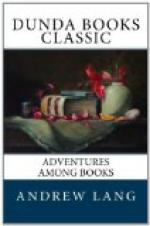The astonishing vividness, again, of the tragedy told in “Geffray Teste Noire” is like that of a vision in a magic mirror or a crystal ball, rather than like a picture suggested by printed words. “Shameful Death” has the same enchanted kind of presentment. We look through a “magic casement opening on the foam” of the old waves of war. Poems of a pure fantasy, unequalled out of Coleridge and Poe, are “The Wind” and “The Blue Closet.” Each only lives in fantasy. Motives, and facts, and “story” are unimportant and out of view. The pictures arise distinct, unsummoned, spontaneous, like the faces and places which are flashed on our eyes between sleeping and waking. Fantastic, too, but with more of a recognisable human setting, is “Golden Wings,” which to a slight degree reminds one of Theophile Gautier’s Chateau de Souvenir.
“The apples now grow green
and sour
Upon the mouldering
castle wall,
Before they ripen
there they fall:
There are no banners on the tower,
The draggled swans most eagerly
eat
The green weeds
trailing in the moat;
Inside the rotting
leaky boat
You see a slain man’s stiffen’d
feet.”
These, with “The Sailing of the Sword,” are my own old favourites. There was nothing like them before, nor will be again, for Mr. Morris, after several years of silence, abandoned his early manner. No doubt it was not a manner to persevere in, but happily, in a mood and a moment never to be re-born or return, Mr. Morris did fill a fresh page in English poetry with these imperishable fantasies. They were absolutely neglected by “the reading public,” but they found a few staunch friends. Indeed, I think of “Guenevere” as FitzGerald did of Tennyson’s poems before 1842. But this, of course, is a purely personal, probably a purely capricious, estimate. Criticism may aver that the influence of Mr. Rossetti was strong on Mr. Morris before 1858. Perhaps so, but we read Mr. Morris first (as the world read the “Lay” before “Christabel"), and my own preference is for Mr. Morris.
It was after eight or nine years of silence that Mr. Morris produced, in 1866 or 1867, “The Life and Death of Jason.” Young men who had read “Guenevere” hastened to purchase it, and, of course, found themselves in contact with something very unlike their old favourite. Mr. Morris had told a classical tale in decasyllabic couplets of the Chaucerian sort, and he regarded the heroic age from a mediaeval point of view; at all events, not from an historical and archaeological point of view. It was natural in Mr. Morris to “envisage” the Greek heroic age in this way, but it would not be natural in most other writers. The poem is not much shorter than the “Odyssey,” and long narrative poems had been out of fashion since “The Lord of the Isles” (1814).
All this was a little disconcerting. We read “Jason,” and read it with pleasure, but without much of the more essential pleasure which comes from magic and distinction of style. The peculiar qualities of Keats, and Tennyson, and Virgil are not among the gifts of Mr. Morris. As people say of Scott in his long poems, so it may be said of Mr. Morris—that he does not furnish many quotations, does not glitter in “jewels five words long.”




